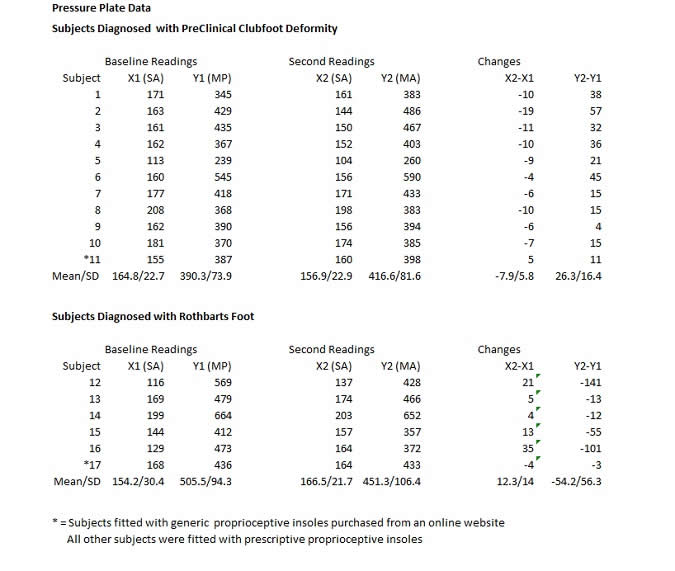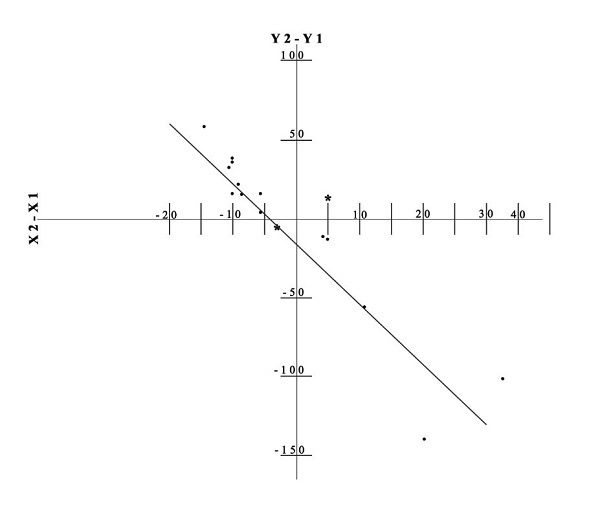Positive Health Online
Your Country

Pressure Plate Analysis of Rothbarts Foot and the PreClinical Clubfoot Deformity
by Brian A Rothbart PhD(more info)
listed in bodywork, originally published in issue 260 - February 2020
Abstract
Standing barefooted, surface area (X) and media pressure (Y) readings were recorded on 11 PreClinical Clubfoot Patients and 6 Rothbarts Foot subjects using the Podolab 2000 pressure plate analysis system. A second set of surface area and media pressure readings were then recorded after each subject used their proprioceptive insoles for 60 seconds.
The collected data was statistically analyzed using ‘Best Fit’ Hypothesis.
The results of the ‘Best Fit’ Hypothesis suggest that prescriptive proprioceptive insoles shift postural tonicity patterns towards homeostasis.
From a clinical point of view, pressure plate readings may prove useful in prognosticating the appropriateness of specific prescriptive proprioceptive insoles when treating either PreClinical Clubfoot Deformity or Rothbarts Foot patients.

Protocol
17 subjects using proprioceptive insoles (11 diagnosed as having the PreClinical Clubfoot Deformity and 6 diagnosed as having Rothbarts Foot by a research Podiatrist) were selected to participate in this study. Exclusion criteria were malocclusions, visual impairments, inner ear/balance impairments, history of foot trauma or surgery, history of any neurological pathology affecting foot function and lower limb or foot amputations (partial or complete). Ages ranged from 11 to 51 (mean of 26 years). Weight ranged from 45 kg to 73 kg (mean of 61 kg). Heights ranged from 1.52 meters to 1.67 meters (mean of 1.62 meters).
The selection of participants was not randomized relative to age, weight, height, sex, social or ethnic backgrounds. All of the subjects were using proprioceptive insoles, dispensed or purchased prior to this study. All of the proprioceptive insoles incorporated medial triangular wedges of various thicknesses fabricated into a flat and flexible 1mm base plate.
A Midi Capteur Podolab 2000 pressure plate system with acquisition frequency of greater than 100 images/second and an analogue/digital conversion of 8 bits (Cedex France) was used to monitor changes in the surface area (∆X) and media pressure (∆Y) readings before and after using proprioceptive insoles. The following protocol was followed without deviation:
(1) Baseline Readings: Each participant walked barefooted around the room for several minutes. Then immediately standing barefoot on the pressure plate in a relaxed posture with eyes directed forward, surface area and media pressure readings were recorded.
(2) 2nd Readings: Each participant then walked around the room for five minutes, wearing their proprioceptive insoles inside their shoes. Then immediately standing barefoot on the pressure plate (no insoles), in a relaxed posture with their eyes directed forward, a second set of surface area and media pressure readings were recorded.
In all, 34 sets of measurements were collected and placed in tabular form (see Table 1).
Theorized Interpretation of ∆X readings
Surface area reading (X) is the mathematical sum of the total surface contact area between the foot and the force plate.
The change in surface area readings (∆X) is predominantly linked to a change in the contact area between the inner longitudinal arch (ILA) of the foot and the force plate. In this study, it is theorized that a:
- Decreased ∆X readings is linked to an increased in the height of the ILA resulting from an increase in tonus in the muscles controlling the arch. This would be the expected response in PreClinical Clubfoot Patients fitted with proprioceptive insoles.
- Increased ∆X readings is linked to a decreased in the height of the ILA resulting from a decrease in muscle tonus. This would be the expected response in Rothbarts Foot patients fitted with proprioceptive insoles.
Theorized Interpretation of ∆Y Readings
In this study, it is theorized that pressure reading (Y) is the mathematical sum of two separate but current forces: the body’s weight (a constant) and the pressure of the toes gripping the force plate (a variable) Therefore, the recorded changes in the pressure readings (∆Y) is the result of a change in digital gripping. It is theorized that a:
- Decreased ∆Y readings is linked to a decrease in digital gripping (decreased foot tonus). This is the expected response when Rothbarts Foot patients are fitted with proprioceptive insoles.
- Increased ∆Y readings is linked to an increase in digital gripping (increased foot tonus). This would be the expected response in PreClinical Clubfoot patients fitted with proprioceptive insoles.
Quick loading and unloading times on the pressure plate was used in an attempt to decrease the possible inaccuracies occurring in the readings from hysteresis.
Based on the theorized interpretation of the ∆X∆Y readings, the following patterns would be expected:
- PreClinical Clubfoot Deformity Patients: -∆X+∆Y
- Rothbarts Foot: +∆x-∆Y
Based on the theorized interpretation of the ∆X∆Y readings, the following patterns would be skewed patterns:
- +∆X+∆Y
- -∆X-∆Y
In each participant, both sets of surface area and media pressure readings were obtained while standing and barefooted. The second set of readings appears is theorized to reflect what is referred to as the engramic effect (a brief carryover of the proprioceptive effect after the insole is removed).
Results
PreClinical Clubfoot Subjects
Ten of the PreClinical Clubfoot Deformity subjects recorded a decrease in their surface area readings and an increase in their media pressure readings using their prescriptive proprioceptive insoles. The only exception was the subject who bought his generic proprioceptive insole from an internet website. He recorded an increase in both his surface area and media pressure readings using his proprioceptive insole. This was a skewed response in relationship to the other 10 subjects.
Rothbarts Foot Subjects
Four of the Rothbarts Foot subjects recorded an increase in their surface area readings and a decrease in their media pressure readings using their prescriptive proprioceptive insoles. The only exception was the subject who bought her generic proprioceptive insole from an internet website. She recorded a decrease in both her surface area and medial pressure readings using her proprioceptive insole. This was a skewed response in relationship to the other 4 subjects.
Four distinct ∆X∆Y distribution patterns emerged from this study: (1) +∆X,-∆Y; (2) -∆X,+∆Y; (3) -∆X, -∆Y; (4) +∆X,+∆Y. Using these ∆X∆Y distribution patterns the ‘Best Fit’ hypothesis was applied:

Linear Regression Analysis
It was postulated that in:
PreClinical Clubfoot Deformity patients, surface areas readings would decrease (the ILA would rise) and media pressure readings would increase (toe gripping would increase) using proprioceptive insoles (e.g., -∆x+∆Y)
Rothbarts Foot patients, surface areas readings would increase (the ILA would flatten) and media pressure readings would decrease (toe gripping would decrease) using proprioceptive insoles (e.g., +∆x-∆Y)
Skewed distribution patterns were predicted as -∆x-∆Y or +∆x+∆Y-
A linear regression model was then applied to the ∆X∆Y distributions patterns.
The regression coefficient was R2 = 0.85 (∆X = -6.28; ∆Y = -3.59) (See Cartesian Graph). This provides a high level of confidence that the interpretation of the recorded ∆X∆Y patterns is consistent with the theorized model suggested in this study.
Discussion
It appears that media pressure readings represent the summation of two separate but concurrent forces:
1. The vertical component of the body’s weight and
2. A smaller vertical component which represents the state of muscle tonicity (toe gripping) within the foot.
This author suggests that the degree of tonus within the muscles that flex the toes, determine the degree of digital gripping (pressure that toes exert against the pressure plate). If the tonus within these toe flexors increase, the digital gripping increases resulting in an increase in the media pressure reading. If the tonus within these toe flexors decrease, the digital gripping decreases, resulting in a decrease in the media pressure reading.
This author also suggests that the degree of tonus within the leg and foot muscles that support the inner longitudinal arch, determine the surface area readings. If the tonus within these foot and leg muscles decrease, the ILA drops, resulting in an increased the surface area reading. If the tonus within these foot and leg muscles increase, the ILA elevates, resulting in a decrease in the surface area reading. This study suggests that the tonicity patterns within these muscles can be altered using proprioceptive insoles.
The distribution patterns may provide an excellent clinical tool in evaluating the appropriateness of proprioceptive insoles used for patients having either Rothbarts Foot or the PreClinical Clubfoot Deformity. If the distribution patterns are skewed, it would indicate that either (1) the dimensioning of the proprioceptive insole incorrect for that particular patient, or (2) there are concurrent tonicity distortions impacting the tonus patterns in the foot and leg (e.g., malocclusions).
Conclusions
It is postulated that proprioceptive insoles should change the tonus in the postural muscles controlling the toe grip and arch height towards homeostasis. These changes in tonus will be reflected in the changes seen in the surface area and media pressure readings: (1) In PreClinical Clubfoot Deformity patients, surface areas should decrease (improved arch contouring) and media pressures should increase (increased toe gripping), (2) in Rothbarts Foot, surface areas should increase (decrease in the arch contour) and media pressures should decrease (decrease in toe gripping).
This was observed/recorded in 15 subjects using prescriptive proprioceptive insoles. Skewed results were observed in 2 subjects using generic proprioceptive insoles (indicating the inappropriateness of those particular insoles).
Both sets of pressure plate readings were taken standing and barefooted. This is consistent with the theorized ability of the body to maintain improved postural homeostasis without continual tactile input, a process referred to as engramic effect.
This interpretation of pressure plate readings is novel and requires further investigation and confirmation using a large-scale, double-blinded study. Until then, this study should be considered investigational and interpreted with discernment.
Comments:
-
No Article Comments available